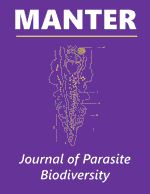Parasitology, Harold W. Manter Laboratory of
ORCID IDs
E. P. Hoberg https://orcid.org/0000-0003-0819-7437
Date of this Version
10-6-2021
Document Type
Article
Citation
MANTER: Journal of Parasite Biodiversity (ISSN 2470-8224) Occasional Papers, Number 16, October 10, 2021.
doi: 10.32873/unl.dc.manter16
Abstract
We begin resolution of the Tetrabothrius jagerskioeldi–species complex with descriptions of Tetrabothrius alcae n. sp. based on numerous specimens, primarily in murres (species of Uria), from the greater North Pacific basin and Tetrabothrius sinistralis n. sp. based on cestodes in guillemots (species of Cepphus) from the central Bering Sea and West Greenland. These tetrabothriids are characterized, among 44 species of Tetrabothrius in avian hosts, by attributes of the scolex, male and female organ systems, structure and dimensions of the vitelline gland, numbers of testes, configuration of the genital atrium, genital papillae and the male and female atrial canals, position of the genital ducts relative to the poral osmoregulatory canals, structure, dimensions and position of the vaginal seminal receptacle, and dimensions of the embryophore and oncosphere, in addition to a broader array of characters. Remarkably, T. alcae, T. sinistralis, and a cryptic complex had remained unrecognized for the past century, given that these species are unequivocally differentiated by multiple suites of unique structural attributes relative to T. jagerskioeldi. Alcids and cestodes of the T. jagerskioeldi–complex are restricted to cold marine systems of advection and upwelling along coastal margins adjacent to the continental shelf or are associated with archipelagos (especially the Aleutian Arc), isolated islands and rocky headlands of the Bering Sea, Chukchi Sea, Gulf of Alaska, Sea of Okhotsk, and Sea of Japan. Tetrabothrius alcae, T. jagerskioeldi, and T. sinistralis may occur in sympatry but with minimal overlap in the faunas associated with murres (Alcini) and guillemots (Cepphini). Transmission for cestodes and persistence of this fauna is expected to be associated with pelagic and neritic systems adjacent to colony sites in zones where critical prey species are concentrated or secondarily dispersed downstream by predictable advective and upwelling processes and become available to foraging birds. Faunal assembly represents the outcomes of oscillating climate, shifting ranges (breakdown in isolation, ecological fitting, and exploration modes for cestodes) and the changing interfaces for resource availability maintained by trophic and habitat overlaps. Dynamics at these ecotones constitute the nexus of opportunity and capacity for infection by species of Tetrabothrius among avian hosts where capacity appears broad and opportunity is ecologically restricted in space and prevatime. Life history pathways for cestodes are tied to trophic associations and dynamics at mesoscales across marine domains and provinces. Resilience and connectivity through ecological fitting strongly suggest the influence of multiple trophic pathways for transmission and persistence of this complex fauna through differing assemblages of zooplankters, fishes, and cephalopods depending on locality, oceanographic conditions, and temporal variability. Changing conditions, especially ecological perturbations driven by climate oscillations, directly determine production cycles and distributions of micro- and macro-zooplankton, forage fishes, cephalopods, and trophic structure in high-latitude marine ecosystems. Expanding regimes of accelerating change emphasize the critical importance of field collections, archives, and baselines to assess biological outcomes across temporal and spatial scales. Parasite assemblages reveal macro- to meso-scale connectivity serving as adjuncts and proxies in recognizing and understanding outcomes for episodes of environmental oscillation and directional atmospheric and oceanic warming in marine ecosystems.


Comments
Copyright © 2021 Hoberg & Soudachanh
License: Creative Commons Attribution-NonCommercial-ShareAlike 4.0 International